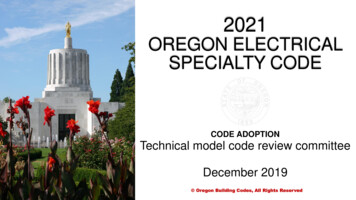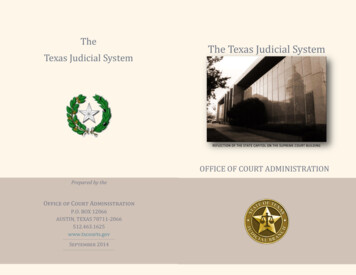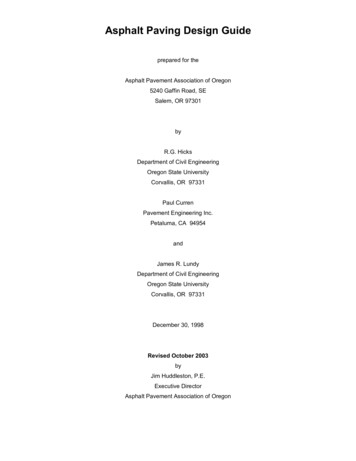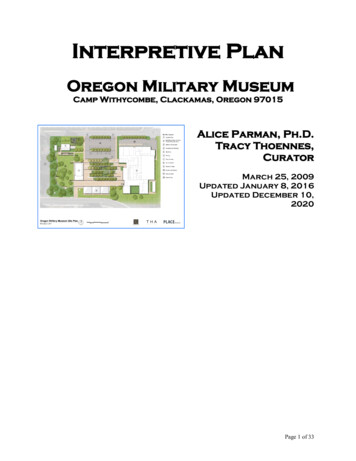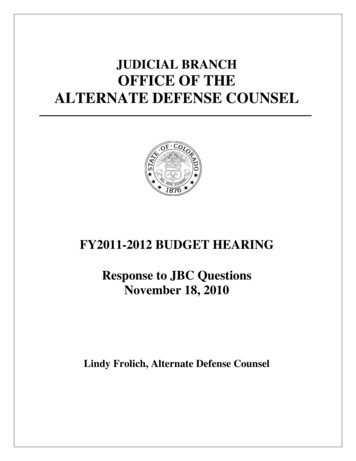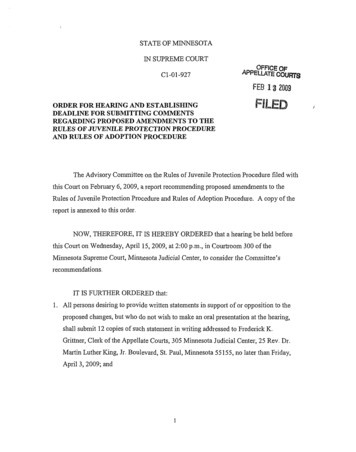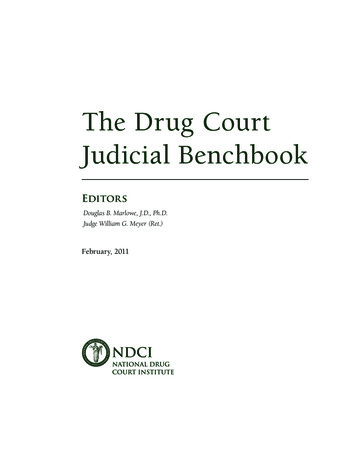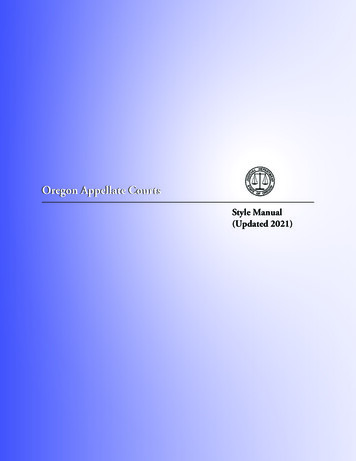
Transcription
Style Manual(Updated 2021)
Errata to the Oregon Appellate Courts Style Manual (Updated 2021)Page 1, PrefaceUpdates ORAP citation:See ORAP 5.20(45) (referring to Style Manual as guide to conventions in style and citation).
OREGON APPELLATE COURTSStyle Manual(Updated 2021)PrefaceThe Oregon Appellate Courts have adopted this style manual as a guideline forconventions used in format, citation, quotation, and style when writing opinions.It is not all-inclusive nor an attempt to dictate writing style. See ORAP 5.20(4)(referring to Style Manual as guide to conventions in style and citation).Sincere appreciation to all who added their time and talent to this project.For form and style questions not covered by this manual,please contact the OJD Publications Program(publications@ojd.state.or.us).
TABLE OF CONTENTSFORMATTINGIn General . 5I. Title PageA. Date of Opinion . 6B. Identifying Caption of the Appellate Court Issuing the Opinion . 6C. Names and Roles of the Parties to the Case. 6D. Identification Numbers . 6E. En Banc. 7F. Court / Agency of Origination . 7G. Trial Court Judge . 7H. Argued and Submitted Date . 7I. Names of Counsel. 7J. Panel of Judges / Justices. 7K. Opinion Author(s) . 7L. Disposition of Case . 8M. Designation of Prevailing Party and Award of Costs . 8II. Body of OpinionIn General . 9A. General Format . 10B. Structural Tools. 11C. Writing Tools . 14CITATIONIn General . 15I. Organization and ArrangementA. The Bluebook . 16B. Consistency of Citations . 16C. Case Names . 16D. Spaces and Abbreviations of Citations . 17E. String Citations. 17F. Signals . 17G. Parenthetical Information . 18II. Case LawA. Oregon–Full Citations . 20B. Oregon–Short Citations and Other Issues . 25C. Federal Jurisdictions . 29D. States Other Than Oregon . 31E. Online Sources . 32III. Constitutional, Statutory, and Other Related CitationsA. Oregon Citations . 33B. Federal Citations . 452
IV. Periodical Articles, Books, Treatises, Restatements, Etc.In General . 48A. Periodical Articles . 48B. Books and Treatises . 49C. Restatements . 51D. Others . 51QUOTATIONIn General . 52I. Citations, Parenthetical Phrases, and FootnotesA. Placement . 53B. Use of Parenthetical Phrases With Quotations Within Text . 55II. Use of Uppercase, Brackets, and Ellipsis Within QuotationsA. Use of Uppercase. 59B. Use of Brackets. 59C. Use of Ellipsis. 62STYLE GUIDEIn General . 66Other Resources . 66I. Spelling, Font, and Treatment of WordsA. Use of Italics and Roman Typeface . 67B. Use of Uppercase and Lowercase . 68C. Numbers and Dates . 72D. Acronyms / Initialisms . 75E. Titles and Offices . 76F.Abbreviations . 76II. PunctuationA. Apostrophes . 77B. Colons . 78C. Commas . 79D. Dashes . 84E. Hyphens . 85F. Punctuating Lists . 87G. Punctuating Parenthetical Elements . 88H. Semicolons . 88III. Word Usage and ConventionsA. Word Pairs . 90B. Word Functions. 101C. Word Usage. 102D. Variant Spellings. 104IV. Common Grammatical and Style ProblemsA. Collective Nouns . 105B. Parallel Construction . 1053
C. Passive Voice . 105D. Verbs . 106E.Active Voice . 107F. Gender-Neutral Wording . 107G. Informal or Technical Terminology . 107GLOSSARY . 108OPINION OVERVIEWSI. Supreme Court . 113II. Court of Appeals . 114III. Tax Court–Regular Division . 115IV. Tax Court–Magistrate Division . 116APPENDIXStandard Proofreader’s Marks . 117INDEX . 1184
FORMATTINGIn GeneralSlip opinions are double spaced; indented quoted material is single spaced andformatted in the same style as the original material; footnotes are placed at the bottomof the page on which they are referenced. Line numbers are set out along the left handmargin, except the footnote section. The courts use Times New Roman, 13-point font.Slip opinions consist of a title page, which includes a designation of prevailingparty and award of costs portion, followed by the body of the opinion. Cases AffirmedWithout Opinion (AWOP) consist of a title page only. Per Curiam Opinions mayconsist of a title page only, but have the same weight of authority as a signed opinion.Therefore, it is not necessary to indicate parenthetically whether an opinion cited isPer Curiam. Cases that are Affirmed By An Equally Divided Court are resolved byopinion—as opposed to an order—and can consist of a title page only unless a concurringor dissenting opinion is written.Listed below are the essential elements found on a standard title page of anappellate court opinion, followed by the substantive components generally containedwithin the body of an opinion. Please note that these are models only and that actual titlepages and opinions may vary due to the particular requirements of an individual case.Go to TABLE OF CONTENTS5Go to INDEX
I. Title PageA.Date of OpinionThe date that the opinion issues is located in the upper right hand corner of thepage preceded by FILED:.B.Identifying Caption of the Appellate Court Issuing the OpinionThe identification of the appellate court is centered on the page in uppercaseletters, e.g.,IN THE SUPREME COURT OF THESTATE OF OREGONIN THE COURT OF APPEALS OF THESTATE OF OREGONIN THE OREGON TAX COURTREGULAR DIVISIONIN THE OREGON TAX COURTMAGISTRATE DIVISIONC.Names and Roles of the Parties to the CaseParties are generally listed in the order in which they appeared in the lower courtor tribunal, but using their appellate court designations: appellant, respondent, petitioneron review, respondent on review, etc. That information is generally taken from theoriginating document filed for a case, e.g., the Notice of Appeal or Petition for JudicialReview.In criminal cases, the STATE OF OREGON is the first party listed, followed bythe full name of the defendant.D.Identification NumbersEach appellate case is assigned a number when filed, which is centered on thetitle page below the names of the parties to the case and preceded by any identifyingnumber(s) from the court or agency in which the case originated. If cases have beenconsolidated on appeal or review, then both appellate case numbers are listed. A SupremeCourt case number begins with an “S,” a Court of Appeals case number begins with an“A,” a Tax Court-Regular Division case number begins with “TC,” and a Tax CourtMagistrate Division case number begins with “TC-MD.”Go to TABLE OF CONTENTS6Go to INDEX
E.En BancIf a case is decided by the full court, then that will be noted in the first line startingat the left-hand margin. No period follows the en banc designation. The initial letter ineach word is in uppercase on the title page (e.g., En Banc), but when used within the textof an opinion, the term is in lowercase letters.F.Court / Agency of OriginationIdentifies where / how the case originated.G.Trial Court JudgeIdentifies judge(s) who signed the appealable judgment(s) or order(s) that are thesubject of the appeal. The Supreme Court footnotes that information on the title page withan asterisk.H.Argued and Submitted DateIdentifies when the case was submitted and whether it was argued. Some cases aresubmitted on the record only.I.Names of CounselThe attorney(s) for all parties to a case are named. If a party appears for himself orherself (sometimes referred to as pro se), then that is noted. A person or entity appearingas amicus curiae is also identified here, along with the counsel of record. Counsel namesare listed as they appear on the signature line of the briefs filed in the case.Regarding Department of Justice (DOJ) attorneys, use official titles (e.g., AttorneyGeneral, Deputy Attorney General, Solicitor General, Deputy Solicitor General, AssistantAttorney General), but do not uses any internal DOJ classification or position description,such as “Attorney-in-Charge, Post-Conviction Section” or “Senior Assistant AttorneyGeneral,” etc.Regarding Office of Public Defense Services (OPDS) attorneys, use official titles(e.g., Chief Defender, Criminal Appellate Section; Chief Defender, Juvenile AppellateSection; Deputy Public Defender), but do not use any internal OPDS classification orposition description, such as “Chief Deputy,” “Senior Deputy Public Defender,” etc.J.Panel of Judges / JusticesThe panel of judges (in the Court of Appeals and also denoting the PresidingJudge) or the names of the Supreme Court justices deciding the case (if not heard en banc)are listed. When denoting a judge who has retired or resigned, a judge’s designation willreflect the status of the judge at the time the opinion issues.Go to TABLE OF CONTENTS7Go to INDEX
K.Opinion Author(s)1.Signed OpinionsThe author’s name is listed in uppercase. When there is a concurringor dissenting opinion, the name of its author is listed on the title page after thedecision line (e.g., Smith, J., dissenting.). Each opinion is arranged in this order:majority; concurring (the authoring justice / judge wishes to write separately,but agrees with both the result and rationale of the majority opinion); speciallyconcurring (the authoring justice / judge wishes to write separately and agreeswith the result, but not the rationale, of the majority opinion); concurring in part,dissenting in part; and dissenting (the authoring justice / judge disagrees with theresult of the majority opinion). If two or more justices / judges file a concurring ordissenting opinion, then the more senior justice’s / judge’s opinion goes first. See,e.g., State v. Dameron, 316 Or 448, 853 P2d 1285 (1993) (for order of opinions).When there is a nonparticipating justice in the Supreme Court, that justice’sname is footnoted on the title page of the opinion.2.Per Curiam OpinionsAn opinion that summarily disposes of the case may be designated as PerCuriam. The Per Curiam designation is also used for all lawyer discipline, Baradmission, and judicial fitness matters before the Supreme Court.3.Affirmed By An Equally Divided CourtIn rare circumstances, the court may be split evenly regarding thedisposition of a case, in which event the case is deemed to be affirmed, althoughno signed majority opinion is issued.L.Disposition of CaseA brief statement of the court’s holding. This holding is repeated as the last line(set out as a separate paragraph) in the body of the opinion and is referred to as the “tagline.” The tag line serves as the court’s formal disposition of the case and also serves asfurther instruction to the lower tribunal(s).M.Designation of Prevailing Party and Award of CostsThe last part of a Supreme Court or Court of Appeals title page denotes theprevailing party and whether, and to whom, the court allows costs.Go to TABLE OF CONTENTS8Go to INDEX
II. Body of OpinionIn GeneralBoth custom and tradition influence the content and format of appellate opinions,as does the individual writing style of each judge. It is not the intent here to dictate thatstyle, but to list standard conventions often used to organize opinions. In describing theelements of a typical opinion, our purpose is to give the reader a better understanding ofappellate opinions.Due to the scrutiny to which a published appellate opinion is subjected, the court’sdiscussion, analysis, and holding need to be expressed clearly, succinctly, and carefully.An opinion is crafted to inform the reader of the legal issues presented, discuss the facts,explain the court’s analysis, and conclude with the court’s final disposition of the case.Because overly long sentences and paragraphs tend to appear formidable, all attempts aremade to present the appellate opinion as straightforwardly as possible. Because appellateopinions are formal documents, contractions are used only when quoting from a source inwhich they appear.Remember, these are general guidelines only, which means that there always willbe exceptions. The requirements of an individual case may demand deviation from thenorms here listed.Go to TABLE OF CONTENTS9Go to INDEX
A.General Format1.Initial Paragraph–Introduction to the CaseThe opinion begins by restating the name of the authoring judge or justiceor by using the Per Curiam designation in uppercase, set out separately as the firstline. The introductory paragraph sets out the general nature of the case, whichincludes the results in any lower tribunal(s), the main issues on appeal / review, andthe final disposition of the court. That provides the framework for the details thatfollow.To the extent possible, the opinion refers to parties by their lowertribunal(s) designations, e.g., plaintiff, defendant, claimant, etc. Exceptions includethe following: (1) domestic relations cases, in which the parties are referred to as“husband” and “wife”; (2) civil commitment proceedings, in which the personfor whom commitment is sought is referred to by his or her position on appeal(appellant, respondent); (3) termination of parental rights proceedings, in whichthe parents are referred to as “mother” and “father,” and the children are referredto as “child” or “children” or sometimes by initials. The proper names of victimsare not used. See page 103 for further discussion.When citing a concurring or dissenting opinion, the author’s last name isused. When a dissenting or concurring opinion refers to the majority opinion, themajority opinion is referred to as such, not by its author.If a party has a long name, a shortened version is usually developed foruse in subsequent references, e.g., First Security Bank of the Northwest may bereferred to simply as “First Security” or “bank.”2.Statement of FactsThe pertinent facts of a case are set out in a concise and objective manner.Those facts can be organized in patterns, e.g., chronologically or geographically,or by issue, witness, or actor. If an issue is complex, the facts may be set out ingeneral here and then in more detail when discussing the issue to which theyrelate.3.Discussion of IssuesThe opinion then addresses the dispositive issue(s) in a manner appropriateto the circumstances of the case. One approach is to state the parties’ positions,either in the order in which they were raised below, discussed in the briefs,or dictated by circumstance; respond to those arguments; and then provide anGo to TABLE OF CONTENTS10Go to INDEX
explanation for the result reached by stating the authorities relied on. Simplystated, the discussion states the issue, how it is resolved on the facts of the casewith citation to relevant authority, and the effect of the resolution.4.Disposition of CaseThe final paragraph states the result and gives instructions when necessary.The conclusion is followed by the tag line, a separate paragraph that sets out thecourt’s final ruling and serves as further instruction to the lower tribunal(s).B.Structural ToolsIf a case is complex, then the authoring judge may decide to divide the opinioninto designated parts and label them to identify for the reader the discussion of the case.That is accomplished by using the methods discussed below.1.Paragraph or Section Headingsa.Format(1)HeadingsAn author may decide to use principal divisions within anopinion. When used, headings for those divisions are centeredand set out in uppercase letters. Roman numerals are not used ifsubheads are omitted.(2)Outline MethodIf dividing and labeling an opinion into sections andsubsections, then the standard outline format is used as set outbelow. Standard outline rules apply, e.g., if there is a headingdesignated I., then there must be a II., if there is a subheading A.,then there must be a B., etc. Initial caps are used in the first levelof subheadings (on all words except articles, prepositions, andconjunctions) unless the subheading reads as a complete sentence.Each new level of subheading starts at a new level of indentation,with an indent following the number or letter.The levels of outlining are referred to as follows:Headings (indicated by Roman numerals)Subheadings (indicated by uppercase letters)Paragraphs (indicated by numerals)Subparagraphs (indicated by lower case letters)Subsubparagraphs (indicated by numbers within parentheses)Go to TABLE OF CONTENTS11Go to INDEX
I. HEADING (centered, uppercase, no italic or boldface font,if there are no subheadings, then do not number headings)A.Subheading Example with Initial UppercaseSet subheading flush left, beginning with nonitalicized alpha character “A.” Indentafter alpha character, followed by italicized subheading. If subheading is not a sentence,then use initial uppercase, but if subheading is a sentence, then use a period and noinitial uppercase after the first word.B.1.Paragraph heading is indented and italicized (do not use initial uppercaseafter the first word; use a period only if a sentence).2.If there is a paragraph 1, then there must be a paragraph 2.a.Subparagraph heading is indented twice, no italics.b.If there is a subparagraph a, then there must be a subparagraph b.(1)Subsubparagraph heading is indented yet again, no italics.(2)If there is a subsubparagraph (1), then there must be asubsubparagraph (2).This is an example of a subheading that does not require initial uppercase but doesuse a period, because it is a sentence.If there is a subheading A, then there must be a subheading B. Paragraphs thatfollow any of these headings are formatted like this one, flush left with a first-line indent.NOTE: With regard to case names in subheadings, if the opinion subheadingsonly involve the first scenario (see below), italicize the case name, which readsbetter to the reader. But, if the opinion subheadings have both scenarios (oronly the second one), then format as follows, for internal consistency:A. State v. BakerB. State v. Jones and its Progenyb.Bulleted or Numbered ListsIt may be more clear to organize certain text, e.g., events, dates,testimony, etc., using a bulleted or numbered list. The bulleted list generallyis indented. The use of bullets can help to differentiate items in a list thatneed no particular order, e.g., Car of little or no value Boat valued at 10,000 Personal jewelry that is valued at more than 5,000, but less than 10,000, and similar items.Go to TABLE OF CONTENTS12Go to INDEX
Numbered lists, with each numeral appearing inside a set of parentheses, help to organize and display information to show relationship, e.g.,Defendant argues as follows: (1) the trial court erred; (2) the error wasnot harmless; and (3) his conviction should be reversed.See pages 87 to 88 for further discussion regarding the properstructure for numbered lists.2.QuotationsWhen construing a statute or administrative rule, for example, the authorgenerally quotes the pertinent text. The purpose of quotation is to provide thereader with the information necessary to understand the court’s discussion of theissues and the law governing its analysis. The proper format for quoted material isdiscussed in the Citation and Quotation sections.3.Footnotesa.In GeneralFootnotes document sources of information or make ancillaryreferences. Substantive information is best addressed within the body of theopinion. Footnote text begins on the same line as the superscripted footnotenumber, except when the footnote begins with a block quotation.b.Citations in FootnotesWhen citing a case in a footnote and the case has not previously beencited (in text or footnote), use the full case citation. If the case has alreadybeen cited (in text or footnote), then use a short citation. (Note that, if a caseis cited for the first time in a footnote, then the first subsequent citation tothat case in the text must also be a full citation. See pages 20 and 25.)c.Referencing to and Setting Out Footnoted Text Within Body of OpinionFootnote numbers, where applicable, are placed after periods,commas, colons, semicolons, and quotation marks. Footnote numbers alsoare placed after a closing parenthesis, unless the footnote refers to materialinside the parentheses. Footnote numbers inserted within quoted materialare set out using superscripted brackets.4.Maps / Pictures / AppendicesIt may be necessary to include graphic information to convey a more clearunderstanding of the issue(s). In that event, a photograph, map, or chart is eitherappended to the opinion or inserted within the text where applicable. When included,an appendix is usually first described in narrative form. The appendix typicallybegins on a separate page at the end of the opinion with the heading “Appendix.”Go to TABLE OF CONTENTS13Go to INDEX
C.Writing Tools1.Fontsa.Italics and UnderscoringItalic typeface is used within opinions to denote case names, to setout introductory signals, to indicate and less common foreign terminology,and to supply emphasis. See examples listed on page 67. Excessive use ofitalics for emphasis is discouraged.Underscoring is used only in quotations when the original sourceused underscoring for emphasis or headings and the like.b.Boldface and UppercaseIt is best to avoid using a variety of styles and fonts within anopinion. Use of boldface or all uppercase letters in text is discouraged as adistraction to the reader. Italic type generally is sufficient to show emphasis.Avoid using UPPERCASE BOLDFACE ITALIC, as it is difficult to read.2.Make Smooth TransitionsWhen turning to a new issue or argument within an opinion, useintroductory sentences or paragraphs to indicate transition between discussions.Use signal words to connect thoughts back to a preceding point or ahead to thenext one, e.g., further, however, consequently, etc. Explore one idea per paragraph,relating each sentence to that central idea.Go to TABLE OF CONTENTS14Go to INDEX
CITATIONIn GeneralIn legal citation, it is paramount to cite authorities in a clear and concise manner,thereby enabling the reader to locate those sources. Within this Style Manual, we haveendeavored to include citation examples of sources often cited within the framework ofappellate opinions. When citing an authority not discussed here, follow the format of likematerial.Citations should be made to official print sources whenever possible. If there is noofficial printed version or if it is difficult to obtain, or the publishing entity has designatedan electronic source as the official version, then citation to that source should follow theformat (as closely as possible) as described within this manual.Go to TABLE OF CONTENTS15Go to INDEX
I. Organization and ArrangementA.The BluebookThe appellate courts generally follow the citation practices set out in the mostcurrent version of The Harvard Law Review Association’s The Bluebook, A UniformSystem of Citation, except as noted in this Style Manual. The Bluebook is used as thedefault source for citation questions not addressed here.B.Consistency of CitationsIf you cannot find a specific rule that addresses your particular citation situation,then cite the authority in a clear, sensible manne
Style Manual (Updated 2021) Preface The Oregon Appellate Courts have adopted this style manual as a guideline for conventions used in format, citation, quotation, and style when writing opinions. It is not all-inclusive nor an attempt to dictate writing style. See ORAP 5.20(4) (referring to Style Manual
